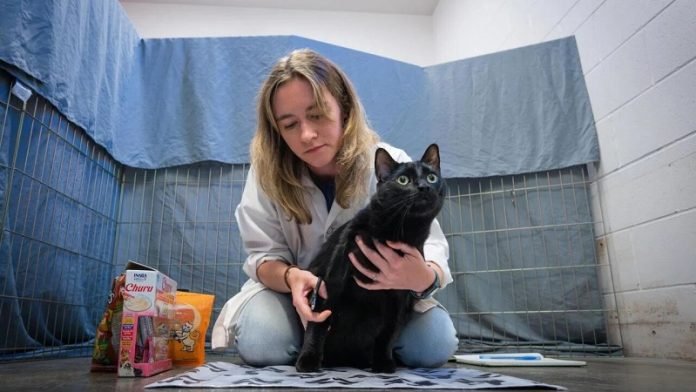
Nail trimming is a common yet challenging task for cat owners and caregivers.
Recognizing this, researchers from the University of California, Davis, in collaboration with the Sacramento SPCA, are developing a new way to make this task less stressful for cats and humans.
The project is spearheaded by Jennifer Link, a Ph.D. student at UC Davis’s Animal Welfare Epi Lab.
She’s on a mission to change how we approach nail trimming – a necessary grooming routine for cats that can often be a source of anxiety for all involved.
Regular nail trimming is essential for the cat’s health and for protecting furniture and other household items.
Starting mid-July, Link began visiting the Sacramento shelter every weekday, dedicating two hours daily to interact with over 70 rescued and surrendered cats.
Her goal is to make these felines more comfortable with human interaction, which is crucial for adapting to new environments and experiences, including nail trims.
Link’s approach involves a multi-step protocol that gradually desensitizes cats to being handled and having their nails trimmed.
This method is part of a concept known as cooperative care, which respects the animal’s choice and comfort level throughout the training process.
In the shelter, Link works in a quiet room with a mat in front of her. A cat receives affection and a treat when it steps onto the mat with its front paws.
This step teaches the cat that positive interactions happen when they approach the mat.
Following this, Link gradually progresses to touching the cat’s legs, then paws, and eventually applying a gentle squeeze to the paws. If the cat does not resist, she trims one nail. The process is patient and responsive, stopping if a cat shows discomfort or disinterest.
This research is part of a larger effort funded by an ASPCA applied behavior grant awarded to Carly Moody, an assistant professor who runs the Animal Welfare Epi Lab.
The ultimate goal is to improve the welfare of cats during routine handling and nail trimming procedures.
Dan Marple, the animal welfare manager at the Sacramento SPCA, emphasizes the significance of this research.
He notes that any protocol that increases comfort and safe handling of cats not only enhances their well-being but also makes them more adoptable.
Moody and Marple both see potential for this protocol to extend beyond the shelter. It could be taught to volunteers and cat owners, transforming a traditionally stressful experience into a positive one.
This approach can also reduce the need for professional assistance with nail trimming, which many cat owners currently seek from clinics and veterinary hospitals.
The next steps for the research team involve analyzing the video sessions of the interactions and finalizing the protocol.
If successful, the technique could be shared with other shelters for further testing and feedback.
This initiative could potentially revolutionize the way we handle and care for our feline friends, making routine grooming a stress-free experience for cats and their caretakers alike.



